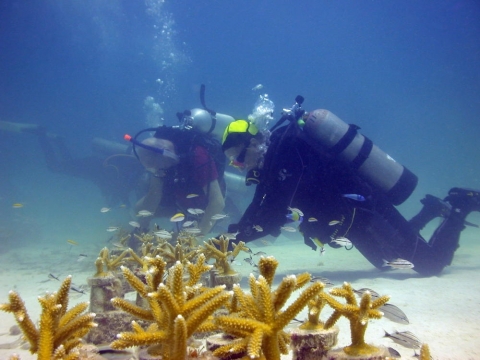Dec212016
Posted at 10:21 AM
Healthy habitat—like wetlands, rivers, and coral reefs—provides important feeding and breeding grounds for fish and other marine life found in the United States. Habitat conservation is also one of the best ways we have for recovering threatened and endangered species.
2016 marks the 25th anniversary of the NOAA Restoration Center, established in 1991 in the wake of the Exxon Valdez oil spill, which impacted a large area of pristine habitat in Alaska. Since then, the Restoration Center has worked with partners across the nation to complete more than 3,300 projects including restoring more than 130,000 acres, opening more than 6,000 miles of streams, and working with more than 365,000 volunteers!
The Center’s work to remove dams and other barriers to fish passage, restore coral and oyster reefs, and rebuild coastal wetlands and kelp forests in the areas that need it most helps to slow the loss of valuable habitat due to coastal development, pollution, and other factors.
Every year, NOAA responds to as many as 150 hazardous substance releases and oil spills like Deepwater Horizon, the largest oil spill in history, which took place in the Gulf of Mexico. Working with federal, state, and tribal partners, the Restoration Center helps to restore the habitat and wildlife affected by these oil and chemical spills.
Restoration projects like these don’t just benefit fish and wildlife—they also boost local economies. Our data show that restoration projects create an average of 15 jobs for every $1 million invested.
Our local communities see the value of restoration too. In removing dams and culverts that have fallen into disrepair, we remove safety hazards. When we restore natural tidal flow to wetlands, we increase the coast’s ability to absorb the impacts of storms and flooding. These projects enhance ecosystem resiliency to the impacts of extreme weather and changing environmental conditions. At the same time, they provide habitat to support sustainable fisheries and contribute to the recovery of protected species for our future generations.
Watch this video celebrating 25 years of restoration success and join us as we recognize the benefits of habitat restoration to fish and wildlife, communities, and the environment. Follow @NOAAFisheries and @NOAAHabitat on Twitter with #Restore25.
This blog is a part of a monthly series highlighting the contributions of the Commerce Department’s agencies to the Open for Business Agenda. This month’s focus is Environment.


